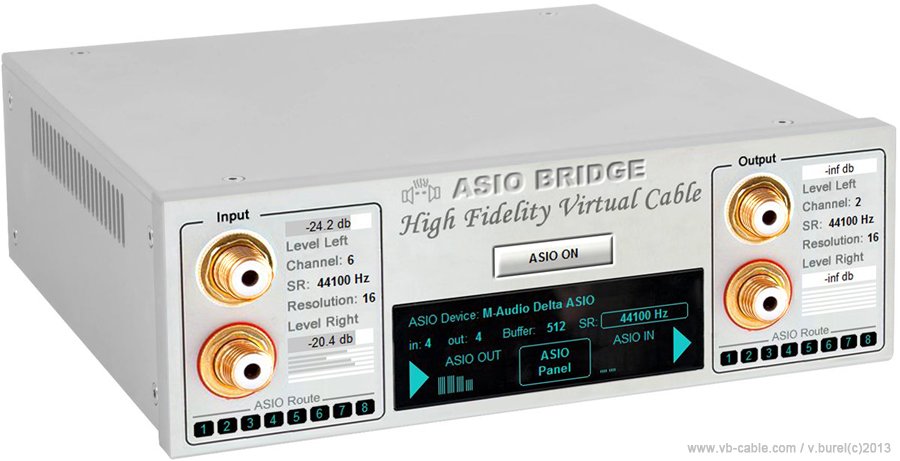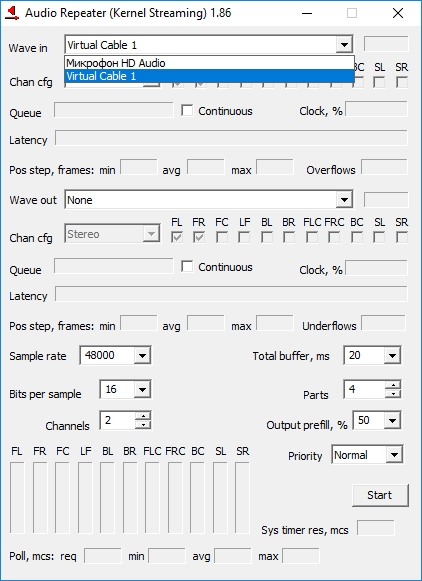Ing tips to assist you in the repair and maintenance of Crest Audio Pro series 3301, 4601, 4801, 6001,. This is class AB operation (figure 4-3). Virtual Audio Cable (VAC) - sound routing/transfer, integrating with DAW, SDR, VoIP, SIP. Simulates a multi-line audio adapter/card with loopback.
| Developer(s) | Eugene Muzychenko |
|---|---|
| Initial release | 14 October 1998; 22 years ago |
| Stable release | 4.65 / 21 January 2021; 8 months ago |
| Written in | C++ |
| Operating system | Microsoft Windows |
| Available in | English |
| Type | Audio software |
| License | Shareware, Freeware (feature-limited) |
| Website | vac.muzychenko.net |
Virtual Audio Cable is a software product based on WDM multimedia driver that allows a user to transfer audio streams from one application to another. Any application is able to send an audio stream to the input side of a 'virtual cable' while a corresponding application can receive this stream from the output side. Since all transfers are made digitally, there is no loss in sound quality. VAC is the audio equivalent of a MIDIloopback device such as MultiMid or Hubi, and can be used instead of 'Stereo Mix' or 'What U Hear' features of audio adapters.[1][2]
If more than one application is sending audio through an output virtual cable, VAC is able to mix all of the streams together or create separate corresponding virtual input cables. Similarly, more than one application is able to receive audio from an input cable, whether it's sharing the same audio data with another target or receiving its own personal audio stream.[3] VAC is useful for recording an application's audio output in almost real time or transferring a sound stream to another application so it may process it. A person could use two or more software audio generators, synthesizers or sequencers to produce audio streams and send them to a VAC output cable and record the mixed stream from the VAC input cable using any type of recording software.

Because VAC routes audio streams in almost real time, it is able to be utilized in various manners. A person is capable of using VAC to record an output audio stream from an application that normally does not allow saving the audio to files.[4] Practically, the input port records the audio signal (from a music player, for example) and sends it to the destination program (such as a sound processor or analyzer) using the output port.[5] A user could also manipulate VAC into recording conversations through Voice Over IP (VoIP)[6] or Internet telephony applications such as Skype[7][8] (for example, with SAM Broadcaster[9]), produce live audio podcasts,[10] redirect audio channels to multiple monitors,[11] or even decode weather faxes.[12]
Vb Audio Cable
Features[edit]
- Windows XP/2003/Vista/7/8/8.1/10 platforms (32-Bit and 64-Bit)
- Native WDM/KS audio technology
- Up 256 Virtual Cables (Windows limits the number of Multimedia Extensions devices to 32)
- 1..20 milliseconds per timer event (formerly interrupt)
- 1..100 pin instances
- Supports almost any of fixed point PCMaudio formats (Floating point formats are not supported)
- Low sound latency with maximal interrupt frequency (1000 Hz, 1 ms period).
- Unlimited number of Kernel Streaming clients connected to each port
- RT Audio (WaveRT) protocol support with notification events, packet mode, clock and position registers. Clock registers are bound to Virtual Cables so all streams in each cable are coherent.
- Signal mixing between output port clients
- PCM format conversion
- Volume control features
- Channel scattering/gathering mode
- Control Panel application to dynamically configure cables
References[edit]
- ^Steven Helstrip (May 1999). 'Create a good compression'. Personal Computer World (PCW) (05): 269. ISSN0142-0232.
- ^'How to FIX Crippled Stereo Mix on a Laptop'. Bright Hub. 2010-09-06. Retrieved 2018-10-13.
- ^VAC UK, software-dungeon.co.uk. Retrieved August 2011 Archived December 19, 2008, at the Wayback Machine
- ^Tobias Hauser, Christian Wenz (2003). 'DRM Under Attack: Weaknesses in Existing Systems'. Digital Rights Management: Technological, Economic, Legal and Political Aspects. Lecture Notes in Computer Science. 2770. Springer Science+Business Media. p. 214. ISBN9783540450382.
- ^'Virtual Audio Cable 4.60 Free Trial - Connect several audio applications together in real time...' Softpedia. 2014-06-05. Retrieved 2018-10-13.
- ^Lingfen Sun; Is-Haka Mkwawa; Emmanuel Jammeh; Emmanuel Ifeachor (2013). '8.3.2. Virtual Audio Cable injection tool'. Guide to Voice and Video over IP: For Fixed and Mobile Networks. Springer Science+Business Media. pp. 202–204. ISBN9781447149057.
- ^Ryo Yoshida; Michiaki Yasumura (July 9–11, 2008). 'A New Cell Phone Remote Control for People with Visual Impairment'. In Klaus Miesenberger; Joachim Klaus; Wolfgang Zagler; Arthur Karshmer (eds.). Computers Helping People with Special Needs. 11th International Conference, ICCHP 2008. Linz, Austria: Springer Science+Business Media. p. 1148. ISBN9783540705390.
- ^Michael Gough (2005). '7. Software Add-ons for Skype'. Skype me! : from single user to small enterprise and beyond. Elsevier. p. 218. ISBN9780080489711.
- ^'Using Virtual Audio Cables to Integrate SAM Broadcaster with Skype'. Spacial. 2018-03-22. Retrieved 2018-10-13.
- ^'How to Produce a Live Audio Podcast'. Barnesian. 2011-10-04. Retrieved 2018-10-13.
- ^'How to redirect same audio channel on all screens using Virtual Audio Cable'. MonitorsAnyWhere. Retrieved 2018-10-13.
- ^'Decoding Multiple Weather Faxes at a Time'. HF Radio Review. 2015-10-26. Retrieved 2018-10-13.
External links[edit]
VB-CABLE (Virtual audio cable) is free software that has virtual emulation interface and uses the WDM driver architecture for audio signal streaming under Windows. The virtual audio card driver is used to transmit audio signal streams from one application to recording application without losing quality. The biggest advantage of this virtual interface saves the hardware cost, and the transmitted signals are all digital, so there is no problem of signal pollution or attenuation. It can be considered as good virtual audio cable alternative to VAC software that is paid and developed by Eugene Muzychenko.
So, if you want to route audio from one application such as Audio/Video player or Youtube to some other recording application without any quality lose then use the tiny VB-Cable software. It works on all Windows platform such as Windows XP/2003/Vista/Windows 7/8/8.1/Windows 10.

How to record PC audio without Mic using Virtual cable?
Step 1: Download VB-CABLE (Virtual audio cable)
As I said VB-CABLE is free, so we can use it as long as without any trial or license expire problem. The developers apart from this application also offer few other software related to audio such as HIFI-CABLE driver. This one works the same as Vb-Cable but needs to be configured with the same sample rate on its Input and its output. HI-FI Cable is bit-perfect and supports up to 24 bits 384 kHz audio stream. It is one of the best Virtual audio cable apps, here is a link to the official website.
Step 2: Install Virtual audio cable
The software will download in the form of a ZIP file in the size of 1.09MB. Once it on your right click and extract the file.
Step 3: Go to VBCABLE_Driver_Packxx folder
After extracting, open the folder that has the VBcable files and if your system is 32-bit right-click on VBCABLE_setup.exe and Run asadministrator. And in case the system is of 64-bit right click on the VBCABLE_Setup_64.exe to install under administrative rights.
Restart system after the installation process.
Step 4: Open Sound Control Panel
Go to Windows 10/8/7 search box and type sound. Alternatively, you can open the Windows Sound settings from the Control Panel-> Hardware and Sound ->Sound.
Under Recording Tab, right-click on the CABLE Output and enable it, in case it not.
Step 5: Select Cable Input as Playback device


Ab Virtual Audio Cable Reviews
Now, the thing is we have to set Virtual audio cable as default device to play music, I mean default to take input. Click on the Playback tab, right-click on the Cable Input and select ” Set as Default Device option.
Virtual Audio Cable Windows 10
Or you can simply click on the Speaker icon given in the Taskbar of Windows in the right side and select the CABLE INPUT (VB-Audio Virtual Cable).
Ab Virtual Audio Cable App
Step 5: Record audio using Virtual audio cable.
Virtual Cable Download
Now, for example, we want to recordsome audio online, like from YouTube. So, what we do, first run the sound recording application. By default, Windows has that, open it and play the song on YouTube. The VB-Cable will automatically route the sound or audio for YouTube to Recording application of Windows. In this way, without losing the quality we can record any voice. It is not only limited to Recording app, but any app that supports audio input will capture the audio played on the Windows system routed by Virtual audio cable.
See: How to use Virtual audio cable to transcribe Youtube videos’ audio to text